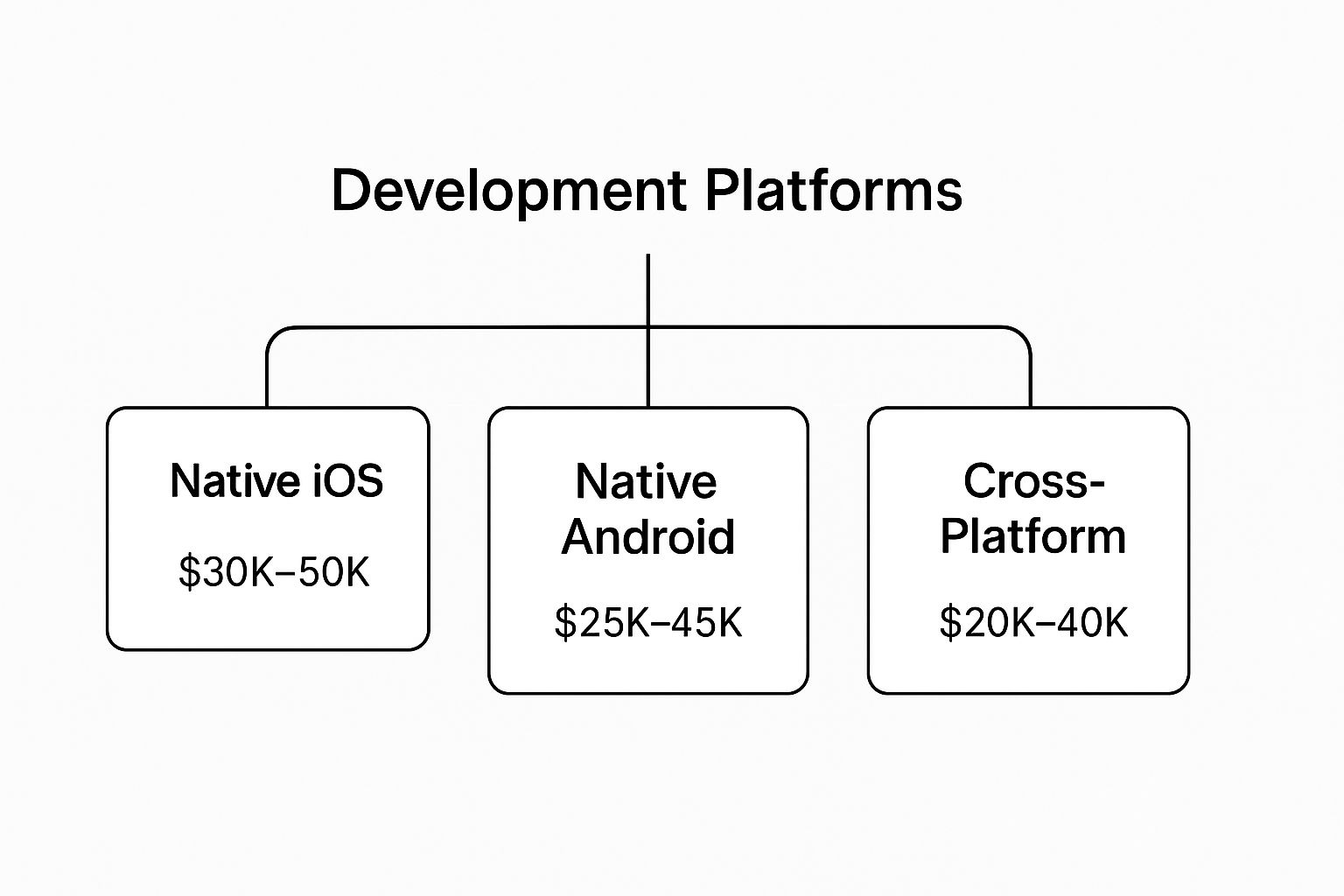How Much Does App Development Cost? Find Out Now
Updated: July 29, 2025

So, you're wondering, "how much does it cost to build an app?" That's a bit like asking, "how much does it cost to buy a car?" The answer can be anything from a few thousand dollars for a reliable used model to a small fortune for a luxury sports car loaded with every feature imaginable. Your app's vision is the blueprint, and the price tag will reflect its ambition.
Your Quick Answer to App Development Costs#

Let's cut right to the chase. There's no fixed price for building an app because every project is different. It's helpful to think of it like building a house. A simple, one-room cabin is going to be worlds apart in cost from a sprawling mansion with custom architecture and smart home technology. App development is exactly the same.
The fundamental rule is this: cost scales directly with complexity. A straightforward app with a few screens and basic features doesn't take nearly as much time or expertise to build. But if you're dreaming up something big—an app with custom user profiles, real-time data syncing, and secure payment processing—you're looking at a much larger investment.
Key Takeaway: The more features you add and the more sophisticated they are, the more time and skill it takes to build them. That's what drives the cost up.
Industry data backs this up, showing a massive range. A simple utility app, like a basic calculator or a to-do list, might get off the ground for around $5,000. On the flip side, a complex mobile app—think a ride-sharing service or something with advanced AI—can easily soar past $250,000. If you want to dig into the numbers, these 2025 mobile app cost projections offer a great look at the current market.
App Development Cost at a Glance#
To give you a clearer starting point, we can group apps into general categories based on how complex they are. This table breaks down what you can generally expect in terms of cost and time for each level. Think of this as a quick reference to see where your idea might fit before we dive into the nitty-gritty details.
| App Complexity | Estimated Cost Range (USD) | Common Features | Typical Timeline |
|---|---|---|---|
| Simple | $15,000 – $45,000 | Basic UI, single-purpose functionality, offline access | 1-3 Months |
| Mid-Level | $45,000 – $150,000 | API integration, user accounts, push notifications | 3-6 Months |
| Complex | $150,000+ | Advanced backend, real-time sync, custom animations | 9+ Months |
This high-level view should give you a solid foundation. Now, let's explore the specific factors that will ultimately shape your final budget.
The Core Factors That Drive Your App's Cost#
So, you have a rough idea of the numbers, but let's get into the why behind them. Understanding the true cost of app development is really about knowing what ingredients go into the final price.
Think of it like building a house. A simple one-room cabin is a world away from a custom-built mansion with a home theater and a swimming pool. The materials, the time, and the expertise required are completely different.
Three main things will shape your app's final price tag: its complexity, the platform you choose, and the location of your development team. Getting a handle on these is your first real step toward building a realistic budget and making smart decisions for your project.
App Complexity And Scope#
By far, the biggest thing that moves the needle on cost is your app's complexity. A simple app with just a few basic screens is like a standard calculator—it does one job well and that's it. On the other hand, an app with custom user profiles, payment systems, and real-time chat is a much more complex beast.
Every single feature you add brings more design work, coding, testing, and backend infrastructure into the mix. All of that translates directly into more development hours.
The cost to build an app in 2025 is completely tied to this.
- Simple apps: Basic user flows, a handful of screens. These sit at the lower end of the cost spectrum.
- Mid-level apps: Features like payment integration, social logins, and real-time updates.
- Complex apps: Advanced features like custom dashboards, multiple API integrations, powerful admin panels, and maybe even a dash of AI.
Key Insight: Every feature is a budget decision. The more you add, the higher the bill. Figuring out your app's absolute core purpose is the secret to keeping costs under control.
This is where planning really pays off. A solid prototype helps you define your scope and lock down those essential features from the start. Learning how to make a prototype isn't just a technical step; it's a financial one that can save you from expensive changes later on.
Platform Choice: iOS, Android, Or Both?#
Your choice of platform—iOS, Android, or both—has a direct impact on your budget. It's simple math: building for one platform is always going to be cheaper than building for two separate ones.
This decision usually comes down to your target audience. If your customers are overwhelmingly iPhone users, starting with a native iOS app is a no-brainer. But if your users are split, you’ve got a bigger decision to make.
This image gives you a great visual breakdown of the typical starting costs for different approaches.

As you can see, a cross-platform approach often looks like a more budget-friendly option if you need to be on both iOS and Android from day one. However, the best path forward really depends on what you need in terms of performance and specific device features.
To get a clearer sense of how this choice fits into the bigger picture, take a look at our guide on the complete mobile app development process. It will help you see exactly where platform selection fits into your project's timeline and overall budget.
Seeing App Complexity Through Real-World Examples#

"App complexity" is one of those terms that gets thrown around a lot, but what does it actually mean for your wallet? It's tough to figure out how much app development costs when the starting point feels so abstract. So, let’s make it real.
We can break down complexity into a few tiers using apps you probably use every day. By seeing where your idea fits, you'll get a much clearer picture of the work—and the budget—involved.
Think of a simple app as a focused digital tool that does one thing really well. A basic calculator or a flashlight app are perfect examples. They typically work offline, have a clean and minimal interface, and don't need to connect to a server to do their job. They're self-contained and straightforward.
The Mid-Level App#
Take a step up, and you get to mid-level apps. These are far more interactive and usually need an internet connection to pull in fresh content. Picture the app for your favorite local coffee shop. It probably has features like:
- User Accounts: So you can save your go-to latte and payment details.
- A Live Menu: Which updates from a central database.
- Mobile Ordering: An interactive system that actually processes your purchase.
- Push Notifications: Little alerts that tell you your order is ready or that a new pastry just dropped.
Each of these features adds another layer. You've got more screens, more ways for users to interact, and a backend server managing all the data. This puts it squarely in the moderate complexity camp. It’s important to remember that each new feature can introduce its own set of mobile app development challenges that can stretch your timeline and budget.
The Complex App Ecosystem#
Finally, we have the heavy hitters: complex apps. Honestly, calling them "apps" is an understatement. They're complete digital ecosystems. Think about giants like Uber or Airbnb. They aren't just one app; they're managing a delicate dance between different user types (drivers and riders, hosts and guests), all while syncing data in real-time.
A complex app is a symphony of moving parts. It involves sophisticated algorithms for matching, real-time GPS tracking for location services, secure multi-currency payment gateways, and review and rating systems—all working together seamlessly.
This kind of functionality demands a powerful and scalable infrastructure, tons of testing, and a much, much larger development team. The price tag reflects that intricacy. Basic apps might run from $30,000 to $60,000, while a mid-level project could be anywhere from $60,000 to $150,000. For a complex platform, you’re often looking at a starting point of $150,000, with the potential to go much higher.
By figuring out where your idea sits on this spectrum—from a simple tool to a sprawling ecosystem—you can finally start building a budget that makes sense.
Choosing Your Platform: Native vs. Cross-Platform#
One of the first, and biggest, financial decisions you'll face is deciding where your app will live. Are you aiming for an iPhone exclusive? An Android powerhouse? Or do you want to be available to everyone, everywhere? This choice between native and cross-platform development will have a massive impact on your budget and timeline.
Think of it like hiring specialized chefs. Going native is like hiring two distinct masters: one is an expert in French cuisine (iOS), and the other is a master of Italian food (Android). To serve both, you need two separate kitchens, two sets of specialized ingredients, and two full-time chefs. The result? The most authentic, high-performance experience you can get on each platform.
Building separate native apps for both iOS and Android offers the absolute best performance and user experience, but it's also the most expensive route, often doubling your initial development cost.
Why the steep price tag? Because your team is literally building, testing, and maintaining two completely separate products from the ground up.
The Native App Trade-Offs#
When you go native, you're also choosing between two very different worlds. Apple's iOS operates in a closed ecosystem. They control the hardware and software, meaning developers only have to worry about a handful of devices. This standardization can seriously speed up the development and debugging process.
Android, on the other hand, opens your app up to a much larger slice of the global market. But this reach comes with a major headache known as device fragmentation. There are thousands of different Android devices out there—from Samsung, Google, and countless others—all with unique screen sizes, processors, and software quirks. Making your app work perfectly on all of them adds a lot of complexity and testing time.
The Cross-Platform Alternative#
So, what if you could hire one incredibly versatile chef who could whip up both French and Italian masterpieces from a single, shared kitchen? That's the magic of cross-platform development.
Frameworks like Flutter and React Native let developers write one set of code that runs beautifully on both iOS and Android. It’s a game-changer for startups and businesses who need to reach everyone without a "build-it-twice" budget. You're building from a single codebase, which dramatically cuts down on development and maintenance hours.
If this sounds like the right move, our guide explains exactly how to build cross-platform mobile apps and will help you weigh the pros and cons for your specific project.
While an iOS app can sometimes cost around 20% more upfront, the endless testing needed for Android's fragmented world can rack up its own hidden costs down the line. For most businesses trying to capture both markets, cross-platform is an incredibly compelling middle ground. It can potentially cut your budget in half compared to building two native apps.
The key is to find the right balance between your budget, your timeline, and the performance your app absolutely needs to deliver. You can dive deeper into these financial nuances with a good app development cost analysis. Making the smartest choice here sets the stage for your app's long-term success.
Budgeting for Hidden and Ongoing App Costs#

Getting your app across the finish line and into the app stores is an incredible feeling. But here's something many first-time founders learn the hard way: that launch day isn't the end of your spending. The initial development bill is really just the first big check you'll write.
It helps to think of your app like a new car. You focus on the big sticker price, but you know you’ll still have to pay for gas, insurance, and regular maintenance to keep it on the road. Your app is exactly the same—it needs a steady stream of investment to run well and stay competitive.
Planning for Post-Launch Investments#
The biggest line item you'll face after launch is app maintenance. This is so much more than just squashing bugs that users find. It's about proactively keeping your app compatible with the yearly OS updates from Apple and Google, which can and will break things if you don't stay on top of them.
Beyond that, a few other recurring costs are non-negotiable if you’re serious about building a real business around your app.
- Server Hosting: All that user data and backend code has to live somewhere. That means paying monthly or yearly fees for cloud hosting services that keep your app online and responsive.
- Third-Party Service Subscriptions: Modern apps are rarely built in a vacuum. You'll likely rely on external tools for things like payment processing (Stripe), mapping (Google Maps), or analytics, and most of these come with their own subscription fees.
- Marketing and User Acquisition: Just because you built it doesn't mean they'll come. You absolutely need a dedicated budget to tell the world about your app and start attracting those crucial first users.
A good rule of thumb is to budget 15-20% of your initial development cost per year for ongoing maintenance. This figure should cover your server fees, bug fixes, necessary updates, and even a baseline for marketing.
Building a Sustainable Financial Model#
Knowing about these post-launch costs from the get-go can be the difference between a passion project that fizzles out and a business that stands the test of time. Especially when looking at your development options, it's vital to grasp all the factors that make up the total outsource software development cost, including these ongoing expenses.
Bake these numbers into your business plan right from the start. It will shape your pricing, inform your revenue projections, and give you a much clearer picture when you're talking to investors. If you plan for these costs, you'll build a much stronger financial foundation and save yourself from some nasty surprises down the road. For a deeper dive, take a look at our guide on mobile app monetization strategies.
Smart Strategies to Control Your App Budget#
Worried your app development costs could spiral out of control? It’s a completely normal fear, but you don't have to mortgage your future to build something great. With a bit of smart planning, you can keep your budget firmly in check without ever skimping on quality.
The single most powerful tool in your arsenal is the Minimum Viable Product, or MVP. Think of an MVP as the purest, most essential version of your app idea. This isn't about launching something that's broken or incomplete; it’s about launching a focused product that solves one core problem for your audience, and does it exceptionally well.
Adopt the MVP Mindset#
Building an MVP forces you to make tough but necessary decisions. You have to pinpoint the absolute must-have features—the ones your app can't live without—and put all the "nice-to-haves" on the back burner for a later version. This approach radically cuts your initial development time and cost.
More importantly, it gets your app into the hands of real users, fast. The feedback you’ll get from these first users is pure gold. It allows you to build what people actually want, not just what you think they want, saving you from spending a fortune on features no one ends up using.
An MVP gets you to market faster, slashes your financial risk, and ensures you're building a product people truly need. It’s the leanest, most effective way to get started.
Plan and Partner Wisely#
Beyond just starting with an MVP, you need solid project management. One of the biggest budget-killers in any project is something called scope creep—that slow, sneaky process of adding more and more features after development has already started. A detailed project plan, locked in from the beginning, is your best defense against these costly detours.
Here are a few other critical strategies to keep costs down:
- Release in Phases: Don't try to build the entire empire at once. Plan to launch in versions. Your MVP is V1. Use the feedback and data from that launch to strategically build V2, then V3, and so on.
- Choose the Right Partner: The development team you hire will be your biggest and most important investment. A truly experienced partner won't just build what you ask; they'll guide you, suggest smarter, more affordable alternatives, and work efficiently.
- Insist on Best Practices: A well-organized project is a cheaper project. Following established mobile app development best practices from day one makes everything run smoother and more predictably. We cover this in detail in our guide to app development best practices.
By combining the MVP approach with smart, disciplined planning, you're not just hoping for the best—you're taking active control of your app's financial future.
Got More Questions About App Costs? Let's Clear Things Up.#
Even after you’ve run the numbers, a few common questions always seem to surface. It's totally normal. Let's walk through some of the big ones so you can move forward with confidence.
So, How Long Does It Really Take to Build an App?#
This is the classic "how long is a piece of string?" question, and the answer always comes back to complexity. There's a big difference between building a simple calculator and the next Uber.
A basic app with just a handful of core features can often come together in 1-3 months. If you're looking at something more involved, maybe with user profiles and connections to other services (APIs), you're probably in the 3-6 month range. For the heavy hitters—think social networks or on-demand services—you should realistically plan for 9+ months of solid work before it’s ready for the world.
Should I Hire a Freelancer or Go With an Agency?#
This is a big one, and it really boils down to your budget and how hands-on you want to be.
Hiring a freelancer is often lighter on the wallet, which is perfect for simpler projects or a Minimum Viable Product (MVP) where the scope is crystal clear. The trade-off? You'll need to be the project manager, actively steering the ship and coordinating everything yourself.
An agency costs more, no doubt about it. But you're not just hiring a coder; you're getting a whole team. You'll have a project manager, designers, multiple developers, and QA testers all working in sync. For complex apps, this is usually the way to go because it takes a huge management load off your plate and gives you one point of contact.
The bottom line: A freelancer is great for straightforward, budget-conscious projects where you can take the lead. An agency is your best bet when you need a full, managed team to tackle a complex build.
Why Do I Keep Hearing I Need a "Backend Server"?#
Not every app needs one, but most do. The easiest way to think about a backend is as your app's central nervous system—it's the powerful, unseen brain that does all the heavy lifting.
This server is what handles all the mission-critical stuff, like:
- Keeping track of user profiles, posts, and settings.
- Making sure logins are secure.
- Sending out those handy push notifications.
- Syncing a user's data across their phone and tablet.
Basically, if your app needs user accounts, has information that changes in real-time, or saves anything for later, it absolutely needs a solid backend to work properly.
Ready to build a native mobile app without the native complexity? NextNative gives you the power to build production-ready iOS and Android apps using the Next.js skills you already have. Get started with our toolkit today!